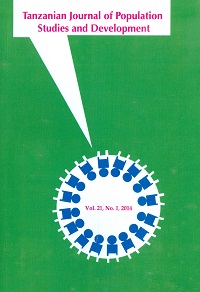' Educated But Still Risky ' Understanding High-Risk Sexual Behaviour Of Unmarried University Students in Tanzania
Abstract
This article seeks to understand risk sexual behaviours associated with HIV transmission among university undergraduate students in Tanzania. This analysis is based on 1119 sexually active never-married students (674 males and 445 females).The results show that 27% of university students (37.8% males and 21.3% females) had sexual intercourse with two or more sexual partners in the past 12 months. More male students than female students tended to have non-regular sexual partners (28% males and 17% females); and commercial sexual partners (6.5% males and 2.9% females). At the same time, condom use at higher-risk sexual intercourse is relatively low (46.0% males and 35.5% females). This is over and above the national average for the same age range. The difference by gender was statistically significant except for condom use at higher-risk sex. In addition, age, duration of stay at the university and staying at university facility or not were tested for their statistical significance to involvement in high-risk sexual behaviours. The article concludes that relatively high prevalence of higher-risk sexual behaviours among university students stems from inadequate attention to the notions of masculinity and femininity, which blurs the efforts that have already been obtained on HIV and AIDS interventions. Thus, there is urgent need to intensify HIV and AIDS related interventions among the university community to create awareness of higher-risk sexual behaviours. Further studies could explore the social and cultural contexts that bring about the observed gender differences in high-risk sexual behaviour among male and female university students.
References
Aggleton, P., A. Ball & P. Mane. 2000. Young People, Sexuality and Relationships. Sexual and Relationship Therapy, 15: 213 €“20
Anderson, E.A. & I. Milsom. 2002. Knowledge about the Prevention of Sexually Transmitted Diseases: a Longitudinal Study of Young Women from 16 €“23 Years of Age. Sexually Transmitted Infections. 78(5): 339 €“341.
Arnold, P., S. Fletcher & R. Farrow. 2002. Condom Use and Psychological Sensation Seeking By College Students, Sexual and Relationship Therapy, 17(4): 355 €“365.
Arowojolu, A.O. 2002. Sexuality, Contraceptive Choice and AIDS Awareness among Nigerian Undergraduates. African Journal of Reproductive Health, 6(2): 60 €“70.
Boerma, J.T., M. Urassa, S. Nnko, R. Ng ' weshemi, R. Isingo, B. Zaba & G. Mwaluko. 2002. Socio-Demographic Context of the AIDS Epidemic in a Rural Area in Tanzania With a Focus on People ' s Mobility and Marriage. Sexually Transmitted Infections 78, Suppl. 1: I97 €“I105.
Boerma, J.T., S. Gregson, C. Nyamukapa & M. Urassa. 2003. Understanding the Uneven Spread of HIV Within Africa: Comparative Study of Biologic, Behavioural and Contextual Factors in Rural Populations in Tanzania and Zimbabwe. Sexually Transmitted Diseases, 30(10): 779 €“87.
Bogaert, A.F & W. A. Fisher. 1995. Predictors of University Men's Number of Sexual Partners. The Journal of Sex Research, 32(2): 119 €“130.
Brooks-Gunn, J. & R. Paikoff. 1997. Sexuality and Developmental Transitions During Adolescence. In J. Schulenberg, J.L. Maggs & K. Hurrelman (Eds.) Health Risks and Developmental Trajectories during Adolescence. New York: Cambridge University Press.
Camlin, C.S. & C.E. Chimbwete. 2003. Does Knowing Someone With AIDS Affect Condom Use? An Analysis from South Africa. AIDS Education and Prevention, 15 (3): 231 ˆ’244.
Cattania, J.A., S.M. Keggles & T.J. Coates. 1990. Towards Understanding of Risk Behaviour: An AIDS Risk Reduction Model (AARM). Health Education Quarterly Spring 1990: 53 €“72.
Eaton, L., A.J. Flisher & L.E. Aaron. 2003. Unsafe Sexual Behaviour in South African Youth. Social Science and Medicine, 56:149 ˆ’165.
Farrow, R. & P. Arnold. 2003. Changes in Female Student Sexual Behaviour During the Transition to University. Journal of Youth Studies, 6, No. 4.
Fisher, S. & B. Hood. 1987. The Stress of the Transition to University: a Longitudinal Study of Psychological Disturbance, Absent-Mindedness and Vulnerability to Homesickness. British Journal of Psychology, 78: 425 €“441.
€”. 1988. Vulnerability Factors in the Transition to University: Self-Reported Mobility History and Sex Differences As Factors in Psychological Disturbance. British Journal of Psychology, 79: 309 €“320.
Golbasi, Z. & M. Kelleci. 2011. Sexual Experience and Risky Sexual Behaviours of Turkish University Students. Arch Gynecolological Obstetrics, 283(3): 531 €“7.
Graber, J.A. & J. Brooks-Gunn. 1996. Transitions and Turning Points: Navigating the Passage from Childhood Through Adolescence. Developmental Psychology. 32(4):768 €“776.
Ha ¨Ggstro ¨M-Nordin E., U. Hanson & T. Tyden. 2005. Association Between Pornography Consumption and Sexual Practices Among Adolescents in Sweden. 2005 International Journal of STD/ AIDS. 16:/102 €“7.
Halamandaris, K.F & K.G. Power. 1999. Individual Differences, Social Support and Coping With Examination Stress: a Study of the Psychosocial and Academic Adjustment of First Year Home Students. Personality and Individual Differences, 26(4): 665 €“685.
Herlitz, C. & J. Steel, 2000. A Decade of HIV/AIDS Prevention in Sweden: Changes in Attitudes With HIV and Sexual Risk Behaviour from 1987 to 1997. AIDS,/14:/881 €“90.
Herlitz, C. & O. Allma ¨Nheten. 2004. HIV/AIDS, Kunskaper Attityder Och Beteenden 1989_2004 (In Swedish). Stockholm: the National Institute of Public Health.


